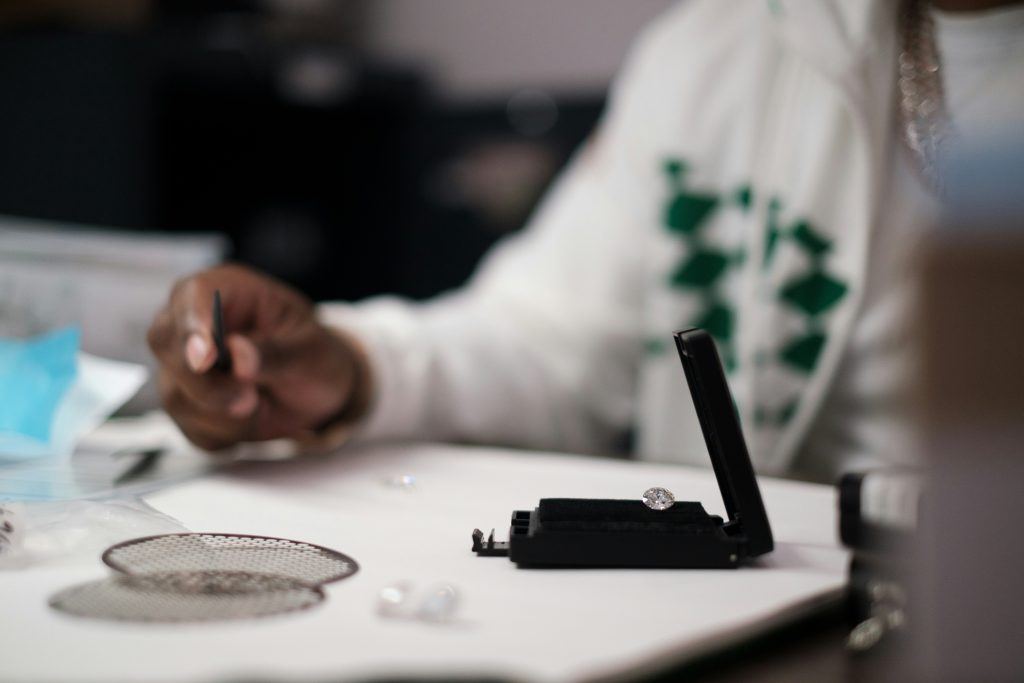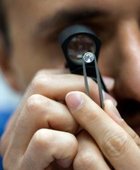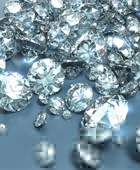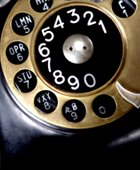Buying your first diamond can be an exciting yet overwhelming experience. Whether it’s an engagement ring, a special gift, or a personal purchase, understanding the complexities of diamonds is essential to making an informed decision. This guide will walk you through every step of the process, from grasping the fundamentals of diamond quality to selecting the perfect setting. By the end of this guide, you’ll be equipped with the knowledge and confidence to buy a diamond that meets your needs and preferences.

1. Understanding the 4 Cs of Diamonds
The 4 Cs—Carat, Cut, Color, and Clarity—are the universal criteria used to evaluate a diamond’s quality. These factors significantly influence a diamond’s appearance and value. Here’s what each of these terms means and how they affect your choice:
- Carat Weight: Carat refers to the weight of the diamond. One carat is equivalent to 200 milligrams. While larger diamonds are often more desirable and expensive, carat weight alone doesn’t determine the diamond’s beauty or brilliance. A well-cut smaller diamond can appear larger than a poorly cut larger one. Consider your budget and preference for size when selecting carat weight.
- Cut: The cut of a diamond is crucial to its sparkle. It refers to how well the diamond has been shaped and faceted, affecting how light reflects and refracts within the stone. The GIA grades diamond cuts on a scale from Excellent to Poor. A well-cut diamond will exhibit brilliance and fire, making it more visually appealing. Even if a diamond has excellent color and clarity, a poor cut can result in a dull appearance.
- Color: Diamond color is graded on a scale from D (colorless) to Z (light yellow or brown). Colorless diamonds (D-F) are the most sought-after and expensive, as they allow the most light to pass through, resulting in more brilliance. However, diamonds in the G-H range can offer a good balance between appearance and value, appearing nearly colorless to the untrained eye.
- Clarity: Clarity refers to the presence of internal or external imperfections, known as inclusions and blemishes, respectively. Clarity is graded on a scale from Flawless (no inclusions or blemishes visible under 10x magnification) to Included (imperfections visible to the naked eye). While flawless diamonds are rare and expensive, most inclusions are microscopic and don’t affect a diamond’s beauty. A diamond with a clarity grade of VS1 (Very Slightly Included) or higher will generally appear flawless to the naked eye.
2. Setting Your Budget
Before diving into the diamond-buying process, it’s essential to set a realistic budget. Diamonds come in a wide range of prices, and your budget will largely determine the quality and size of the diamond you can afford. Here are some tips for setting your budget:
- Know Your Priorities: Decide which of the 4 Cs are most important to you. For example, if size is your top priority, you might choose a slightly lower color or clarity grade to maximize carat weight. Conversely, if brilliance is your priority, you might opt for a smaller, well-cut diamond.
- Consider the Setting: Don’t forget to factor in the cost of the setting when setting your budget. The setting not only secures the diamond but also enhances its appearance. Settings can range from simple and affordable to elaborate and expensive.
- Stick to Your Budget: It’s easy to get carried away when shopping for a diamond, but it’s important to stay within your budget. Remember that the sentiment behind the diamond is more important than its price tag.
3. Choosing the Right Diamond Shape
Diamonds come in various shapes, each offering a unique look and appeal. The shape you choose will depend on personal preference, style, and how the diamond will be worn. Here’s a breakdown of the most popular diamond shapes:
- Round: The round brilliant cut is the most popular and classic diamond shape. It’s known for its superior sparkle and timeless appeal. Round diamonds are versatile and work well in any setting.
- Princess: The princess cut is a square or rectangular shape with pointed corners. It’s the second most popular shape and offers a modern look with plenty of brilliance. Princess-cut diamonds often appear larger for their carat weight compared to round diamonds.
- Cushion: The cushion cut, also known as a pillow cut, is a square or rectangular shape with rounded corners. It combines the brilliance of a round cut with the uniqueness of a square shape. Cushion-cut diamonds have a vintage feel and are often chosen for antique-style settings.
- Oval: Oval diamonds are elongated versions of the round brilliant cut. They offer a similar level of sparkle with a unique, elongated shape that can make fingers appear longer and slimmer.
- Emerald: The emerald cut is a rectangular shape with stepped facets, creating a hall-of-mirrors effect. This cut emphasizes clarity over brilliance, making inclusions more noticeable. However, its elegant and sophisticated appearance is highly sought after.
- Marquise: The marquise cut is an elongated shape with pointed ends. It maximizes carat weight, making the diamond appear larger. The marquise cut is dramatic and often chosen for its striking appearance.
- Pear: The pear shape combines the round and marquise cuts, with a rounded end tapering to a point. It’s a unique and elegant choice, often used in pendants and earrings as well as rings.
- Asscher: The Asscher cut is similar to the emerald cut but square in shape. It has a vintage appeal with a deep pavilion and high crown, creating a hall-of-mirrors effect. Asscher-cut diamonds are often chosen for their Art Deco style.
- Radiant: The radiant cut combines the elegance of the emerald cut with the brilliance of the round cut. It’s a rectangular or square shape with cropped corners, offering a modern yet classic look.
- Heart: The heart shape is a symbol of love and romance. It’s a unique and distinctive choice, often used for special occasion jewelry.
4. Selecting a Diamond Setting
The setting of a diamond plays a crucial role in its overall appearance and security. The right setting can enhance the diamond’s beauty and reflect the wearer’s style. Here are the most common types of settings:
- Prong Setting: The prong setting is the most popular and classic setting, featuring metal claws that hold the diamond in place. Prongs allow maximum light to pass through the diamond, enhancing its brilliance. This setting is versatile and works well with most diamond shapes.
- Bezel Setting: The bezel setting features a metal rim that encircles the diamond, holding it securely in place. This setting offers a sleek and modern look while providing excellent protection for the diamond. It’s ideal for those with an active lifestyle or those who want a more contemporary appearance.
- Pavé Setting: In a pavé setting, the band is encrusted with small diamonds, creating a continuous sparkle. The diamonds are set close together with minimal metal visible, giving the appearance of a diamond-encrusted band. This setting adds extra sparkle and is often used in engagement rings and eternity bands.
- Halo Setting: The halo setting features a central diamond surrounded by a ring of smaller diamonds. This setting enhances the appearance of the center diamond, making it appear larger and more brilliant. The halo setting is popular for its vintage-inspired look and extra sparkle.
- Channel Setting: In a channel setting, diamonds are set into a channel within the band, with no metal between them. This setting is often used for wedding bands and eternity rings, offering a sleek and continuous line of diamonds. It’s a secure setting that protects the diamonds from damage.
- Tension Setting: The tension setting uses the pressure of the metal band to hold the diamond in place, giving the illusion that the diamond is floating. This modern and minimalist setting allows maximum light to enter the diamond, showcasing its brilliance. However, it requires precise craftsmanship to ensure the diamond is secure.
- Bar Setting: Similar to the channel setting, the bar setting features diamonds set between vertical metal bars. This setting offers a contemporary look with the diamonds securely held in place. It’s often used for wedding bands and anniversary rings.
- Cluster Setting: In a cluster setting, several smaller diamonds are grouped together to create the appearance of a larger diamond. This setting is an economical option for those who want a statement piece without the cost of a large diamond.
- Three-Stone Setting: The three-stone setting features three diamonds, often representing the past, present, and future. The central diamond is usually larger, flanked by two smaller diamonds. This setting is symbolic and offers a classic yet meaningful design.
5. Assessing Diamond Certification
A diamond certification, also known as a grading report, is a document issued by an independent gemological laboratory that details the characteristics of the diamond, including the 4 Cs (Carat, Cut, Color, Clarity) and other important factors like fluorescence and symmetry. Certification is crucial for ensuring the quality and authenticity of the diamond you’re purchasing. Here’s what you need to know:
- Reputable Certification Laboratories: The most trusted certification laboratories include the Gemological Institute of America (GIA), the Hoge Raad voor Diamant (HRD), and the International Gemological Institute (IGI). GIA is the most widely recognized and respected, known for its strict grading standards. HRD is well-regarded, especially in Europe, while IGI is popular in retail markets and offers more accessible certification services.
- What to Look For: A diamond certificate should clearly state the diamond’s 4 Cs, as well as additional details like proportions, polish, symmetry, and any treatments or enhancements the diamond has undergone. Always ensure that the certificate is from a reputable lab to avoid the risk of purchasing a misrepresented or synthetic diamond.
- Why Certification Matters: Certification provides assurance that the diamond is natural and meets the quality standards you’re paying for. It also protects your investment, as certified diamonds generally hold their value better and are easier to resell or insure.
6. Balancing the 4 Cs for Best Value
While each of the 4 Cs is important, balancing them based on your budget and preferences can help you get the best value for your money. Here’s how to approach this:
- Prioritize Cut: The cut of the diamond has the most significant impact on its brilliance and overall appearance. Even if you have to compromise on carat weight, color, or clarity, prioritize a good or excellent cut. A well-cut diamond will sparkle more and appear more visually appealing than a larger or clearer diamond with a poor cut.
- Find a Balance with Color and Clarity: For most buyers, a diamond in the near-colorless range (G-H) offers an excellent balance between cost and appearance. Similarly, a clarity grade of VS1 or VS2 usually provides a diamond that looks flawless to the naked eye without the premium price of a higher clarity grade. Consider that inclusions that are not visible to the naked eye (eye-clean diamonds) can offer better value.
- Consider Carat Weight Last: While carat weight is often the most visible characteristic, it’s not always the most important. A slightly smaller diamond with better cut, color, and clarity can be more impressive than a larger diamond with lower grades. Choose a carat weight that fits within your budget while allowing you to prioritize the other three Cs.
7. Diamond Fluorescence: What You Need to Know
Fluorescence refers to a diamond’s tendency to emit a soft glow when exposed to ultraviolet (UV) light. This characteristic can affect a diamond’s appearance and value:
- Fluorescence Grading: Fluorescence is graded from None to Very Strong. In most cases, fluorescence has little to no impact on the appearance of the diamond under normal lighting conditions. However, strong fluorescence can sometimes cause the diamond to appear hazy or milky in sunlight.
- Impact on Value: Diamonds with strong fluorescence may be slightly discounted, as some buyers prefer diamonds without this characteristic. However, in lower color grades (J and below), fluorescence can actually enhance the diamond’s appearance by making it appear whiter.
- Should You Avoid Fluorescence? Fluorescence is not necessarily a negative trait. In fact, many diamonds with medium to strong fluorescence are indistinguishable from non-fluorescent diamonds under normal conditions. If budget is a concern, a diamond with fluorescence might offer a better value without sacrificing beauty.
8. The Importance of Diamond Shape and Setting Compatibility
The shape of the diamond you choose should complement both the setting and the wearer’s lifestyle. Here’s how to ensure compatibility:
- Matching Shape to Setting: Certain diamond shapes work better with specific settings. For example, a round brilliant diamond pairs beautifully with most settings, while a marquise or pear shape might be better suited for a solitaire or halo setting to protect the pointed ends. Similarly, emerald and Asscher cuts, with their step facets, are often showcased in more simple settings that highlight their clarity.
- Lifestyle Considerations: If the wearer has an active lifestyle, consider more secure settings like bezel or channel settings that protect the diamond from accidental damage. Prong settings offer maximum brilliance but can be more prone to snagging or loosening over time.
- Metal Choices: The metal of the setting can also influence the diamond’s appearance. White metals like platinum or white gold can enhance the colorlessness of a diamond, while yellow or rose gold can complement warmer color grades. Additionally, consider the durability of the metal—platinum is more durable but also more expensive, while gold offers a range of color options and price points.
9. Ethical Considerations: Conflict-Free and Lab-Grown Diamonds
In recent years, there has been increasing awareness of the ethical issues surrounding diamond mining, leading many buyers to seek out conflict-free or lab-grown diamonds:
- Conflict-Free Diamonds: Conflict-free diamonds are sourced from mines that adhere to strict labor and environmental standards, ensuring that the purchase does not fund armed conflict or exploit workers. The Kimberley Process Certification Scheme is one way to verify that a diamond is conflict-free, though it’s important to note that the process has its limitations. Many jewelers now offer additional certifications or guarantees that their diamonds are ethically sourced.
- Lab-Grown Diamonds: Lab-grown diamonds are created in a controlled environment using advanced technological processes. These diamonds are chemically and physically identical to natural diamonds but are often priced lower and come with the added benefit of being environmentally friendly and conflict-free. Lab-grown diamonds have become increasingly popular, particularly among socially conscious buyers.
- Weighing the Options: When deciding between a natural and lab-grown diamond, consider factors such as price, environmental impact, and personal values. Lab-grown diamonds can offer a more affordable and ethical option without compromising on quality, while natural diamonds hold historical and cultural significance that may be important to some buyers.
10. Finalizing Your Purchase: Tips and Considerations
Once you’ve chosen your diamond and setting, there are a few final steps to ensure a smooth purchase:
- Compare Prices: Before making a final decision, compare prices from different retailers, both online and in-store. Ensure that you’re getting a fair price by comparing diamonds with similar specifications.
- Review Return Policies: Make sure the retailer offers a return policy or exchange option in case the diamond does not meet your expectations. This is especially important when purchasing online.
- Consider Insurance: Diamond jewelry is a significant investment, and insuring your purchase can provide peace of mind. Many jewelers offer insurance as part of the purchase, or you can add the diamond to your existing homeowners or renters insurance policy.
- Obtain a Proper Appraisal: An independent appraisal from a certified gemologist can verify the diamond’s value and ensure that it matches the specifications on the certificate. This is especially useful for insurance purposes.
11. Conclusion
Buying your first diamond is a memorable and significant experience. By understanding the 4 Cs, setting a realistic budget, choosing the right shape and setting, and considering certification and ethical factors, you can make an informed decision that aligns with your needs and values. Whether you opt for a natural or lab-grown diamond, remember that the most important aspect is the thought and care behind the purchase. With this guide, you’re well on your way to finding the perfect diamond that will bring joy for years to come.




